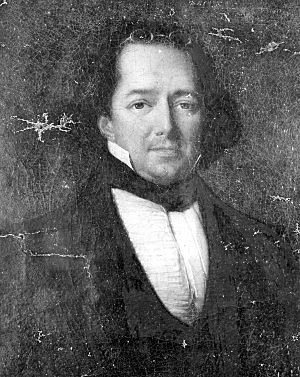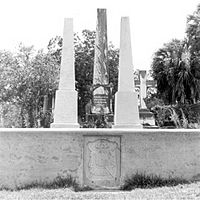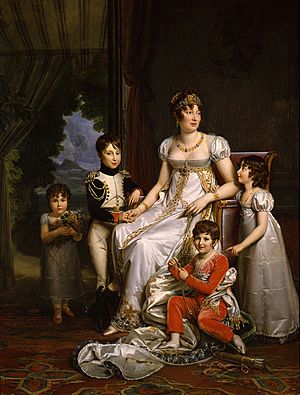Achille Murat facts for kids
Quick facts for kids Achille Murat |
|
|---|---|
 |
|
| Prince Murat | |
| Tenure | 13 October 1815 – 15 April 1847 |
| Predecessor | Prince Joachim |
| Successor | Prince Lucien |
| Born | 21 January 1801 Paris, France |
| Died | 15 April 1847 (aged 46) Jefferson County, Florida, U.S. |
| Spouse | Catherine Willis Gray |
| Father | Joachim Murat |
| Mother | Caroline Bonaparte |
Charles Louis Napoleon Achille Murat (born January 21, 1801 – died April 15, 1847) was a fascinating person. He was the oldest son of Joachim Murat, who was Napoleon's brother-in-law. His father became the King of Naples during the time of the First French Empire. After his father lost his throne and was executed, Achille Murat and his family had to leave their home and live in Austria.
When he was 21, Achille Murat moved to the United States. He settled in St. Augustine, Florida. He became an American citizen after July 1828 and stopped using his European royal titles.
Contents
Achille Murat's Life Story
Growing Up as a Prince
Achille Murat was born in Paris, France. His father, Joachim Murat, came from a farming family. He became a very loyal follower of Napoleon. Joachim Murat was made a top military leader, called a Marshal of the Empire. Later, Napoleon made him a king, giving him the throne of the Kingdom of Naples.
Achille's mother was Caroline Bonaparte, who was Napoleon's sister. She was known as the Grand Duchess of Berg and the Queen of Naples. Achille was considered the crown prince, meaning he was next in line to be king.
His governess, Catherine Davies, took care of him. She later wrote a book about her eleven years with the Murat family.
From Europe to America
After Napoleon was sent away from France for the second time in 1815, Achille's father, Joachim Murat, was removed from power and executed. Young Achille and his brothers and sisters went with their mother to live in exile in Austria.
When Achille turned 21, he got permission to move to the United States. In 1821, he sailed from a Spanish port to New York. When he arrived, Murat immediately applied to become an American citizen.
After a few months in New York, he traveled widely across the United States. He looked a lot like his famous uncle, Napoleon. Even though he gave up his royal titles, his connections helped him meet important people. He became friends with Richard K. Call, a representative from the Florida Territory.
Life in Florida

Richard Call told Murat about new opportunities in the Florida Territory. The United States had just gotten Florida from Spain in 1821. In 1824, Murat moved to St. Augustine, Florida. He rented a house now called the Prince Murat House.
Murat quickly became involved in St. Augustine life. He joined the Masonic lodge and got involved in local politics. He also joined the local army, called the militia. He even volunteered under his friend, General Joseph Marion Hernández.
Murat bought a large piece of land, about 2,800 acres. He built a plantation there and grew oranges, sugar cane, cotton, and tobacco. He named his plantation 'Parthenope'. This name honored his former principality in Naples, Italy.
Parthenope was about 10 miles south of St. Augustine. Murat was known for trying unusual foods, like baked turkey buzzard and stewed alligator. He also had some unusual habits, like not liking baths very much.
Around 1825, Murat bought another property called Lipona Plantation. It was about 15 miles east of Tallahassee, Florida. He lived there for the rest of his time in Florida. The name Lipona is "Napoli" (Naples) spelled backward. This was a nod to the kingdom where he once thought he would become king.
He bought Lipona because the Marquis de Lafayette encouraged him. Lafayette had received a large land grant near Tallahassee.
Some stories say Murat was an elected official in Tallahassee, like an alderman or mayor. However, historical records do not support these claims. Tallahassee did not even have a city council until 1825.
Murat met Catherine Willis Gray in 1826 and they married on July 12 of that year. They did not have any children. Catherine was a great-grandniece of George Washington.
Murat was a supporter of Jacksonian ideas in politics. In 1826, he had a disagreement with his neighbor, David Betton Macomb. They met for a duel. Murat's shot missed Macomb, but Macomb's shot hit Murat's little finger.
During the early part of the Second Seminole War, Murat was a lieutenant colonel in Florida's militia. He served as an aide to General Richard K. Call. He kept the rank of colonel for the rest of his life.
Friendship with Ralph Waldo Emerson
In the winter of 1826, Murat met the American writer Ralph Waldo Emerson in St. Augustine. They became good friends. They enjoyed talking about politics, society, and history. Emerson wrote about Murat:
- A new event is added to the quiet history of my life. I have connected myself by friendship to a man ... with as ardent a love of truth as that which animates me, with a mind that surpasses mine in the variety of its research, & sharpened & strengthened to an energy for action to which I have no pretension by advantages of birth & practical connection with mankind beyond almost all men in the world.
Like another writer, Alexis de Tocqueville, Murat was one of the first people to write about American culture. He wrote his observations in French, Italian, and English. He wrote about slavery, money, and books. However, his books were not very popular. Murat supported slavery, even though he said he fought for freedom.
Return to Europe and Back to Florida

After a revolution in France in 1830, Murat went back to Europe. He was given command of a military group in Belgium. While in Belgium and France, he hoped to get back some of his family's money. But he was not successful. In 1834, the Murats returned to Florida.
In 1835, Murat and his wife moved to Louisiana. He bought a sugarcane plantation near New Orleans and a house in the city. They lived there for several years while he worked as a lawyer, but he did not have much success.
After they returned to Florida, Murat had to use his Lipona property as a loan guarantee. He lost it in 1839 because he could not pay his debts. This was due to a financial problem that started in 1837. He and his wife had to move to a smaller plantation called Econchatti. This was in what is now Jefferson County, Florida.
Murat died there in 1847. He was buried in the St. John's Episcopal Church cemetery in Tallahassee.
Murat's cousin, Napoléon III of France, helped his widow. He gave her $40,000 and money each year. This allowed her to live comfortably. She was better at managing money than her husband. In 1854, she bought the Bellevue Plantation. She hosted friends there until after the American Civil War. Catherine Murat died in 1867 and was also buried at the St. Johns Episcopal Church cemetery. In 1967, the Bellevue plantation house was moved to Tallahassee. It is now part of the Tallahassee Museum.


